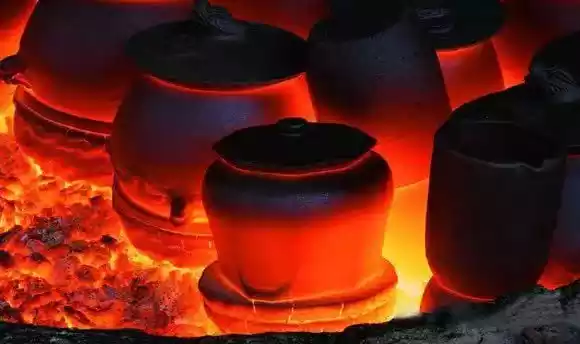세라믹 가마용 내화 벽돌을 선택하기 위한 요구 사항은 무엇입니까?
생산 기술의 향상으로, 세라믹 가마는 내화 재료에 대한 더 높은 기준과 요구 사항을 가지고 있습니다.. 현재, 세라믹 가마는 세라믹 제품을 소성하는 기능을 만족시키면서 가마의 수명을 최대한 향상시키고 에너지를 절약해야 합니다.. 세라믹 가마의 다른 부분은 다른 내화물을 사용합니다.. 세라믹 가마에 사용되는 내화물은 두 가지 범주로 나눌 수 있습니다: 보온 및 단열.

세라믹 가마의 내화물에 대한 요구 사항은 무엇입니까?
내화 벽돌의 열전도율
세라믹 가마는 열전도율이 낮은 내화물을 사용합니다., 가마의 표면 온도를 낮출 수 있습니다., 열 방출의 손실을 줄입니다, 도자기 생산 비용을 절감하고.
굴곡강도
내화 벽돌의 굴곡 강도는 세라믹 가마의 구조적 안정성에 일정한 영향을 미칩니다.. 굴곡 강도가 높은 내화 벽돌은 가마의 수명을 연장하고 열팽창으로 인한 가마의 변형 및 균열을 줄일 수 있습니다.. 게다가, 굽힘 강도가 높은 내화 벽돌은 세라믹 가마가 더 높은 하중을 지탱할 수 있도록 보장합니다..
부하 연화 온도
일반적으로, 세라믹 가마 내부 층 재료의 부하 연화 온도는 가마의 정상 작동 온도보다 100-500°C 높아야 합니다., 도자기 벽돌 가마를 굽는 것과 같은, 소성 구역 내층 재료의 부하 연화 온도는 1380°C보다 높아야 합니다.. 그렇지 않으면, 가마 가동 중 또는 단기 가마 온도가 장기 사용 온도보다 높아 가마에 점화하여 구울 때, 퍼니스 본체가 변형되거나 심지어 가라앉아 손상될 수 있습니다..
재연소 라인의 변경
최대 작동 온도는 재점화 라인이 다음보다 더 이상 변하지 않는 실험 온도를 나타냅니다. 2% ~을 위한 24 몇시간 연속 보온. 내화 세라믹 섬유판을 세라믹 가마에서 사용하는 경우, 고온에서 과도한 재소화 수축이 발생하는 경우, 퍼니스 본체가 손상됩니다.. 벽돌 조인트의 증가는 퍼니스 본체의 완전성과 기밀성에 영향을 미칩니다., 심지어 용광로 본체 구조에 손상을 줄 수도 있습니다., 특히 가마 지붕 벽돌, 수축으로 인해 가마 지붕이 가라앉고 변형됩니다.. 상대적으로 말하면, 불타는 팽창은 덜 해롭다, 특히 작은 팽창은 가마 본체의 수명을 연장하는 데 좋은 영향을 미치는 경우가 많습니다..
열충격 안정성
열충격 안정성이란 내화물이 손상되지 않고 급격한 온도 변화에 저항하는 능력을 말합니다.. 세라믹 가마 내 내화 벽돌의 열 충격 안정성에 대한 특정 요구 사항도 있습니다..
배치 가마의 경우, 가마 본체는 각 작업마다 상온에서 세라믹 제품의 소성 온도까지 가열되어야 하며 일정 시간 동안 유지한 후 상온으로 낮추어야 합니다.. 이렇게 가열과 냉각을 반복하면서, 내화물의 내열충격성이 좋지 않은 경우, 깨지기 쉽다, 다루기 힘든 벽돌을 벗기고 도십시오, 심한 경우 가마 본체가 붕괴될 수 있습니다..
연속 작동이 가능한 세라믹 가마용, 터널 가마, 롤러 가마 등, 밤낮으로 계속 운영되고 있지만, 가마의 전원이 꺼진 경우에도 가마 종료가 발생합니다., 연료가 끊겼어, 장비가 손상되었습니다, 그리고 주기적인 유지관리. 가마를 정지할 때마다 소성온도에서 상온으로 내려갔다가 소성온도까지 가열하는 과정을 의미한다., 따라서 가마의 수명은 내화물의 열충격 저항과 밀접한 관련이 있습니다..
게다가, 세라믹 가마 가구 및 가마 자동차의 경우 열충격 안정성이 더욱 중요합니다., 끊임없이 더위와 추위를 반복하는. 그러므로, 가마 가구 및 가마 차량에 사용되는 세라믹 섬유판은 열충격 저항성이 좋아야 합니다..
 Rongsheng 내화물 공장
Rongsheng 내화물 공장
위챗
위챗으로 QR코드 스캔